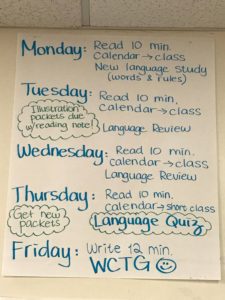If you are a teacher and you look up the term “decision fatigue” you will probably find a lot of information that you can relate to. Teachers have to make hundreds if not thousands of micro- and macro- decisions in the course of their day. Studies show that this is simply exhausting emotionally, mentally and physically. For the sake of our mental health, teachers need to reduce the number of decisions we must make in a given day.
One way to do this is to implement classroom routines, and a fixed weekly schedule that is the same (or similar) across different levels. Tina Hargaden‘s weekly schedule has inspired me to be more systematic about this (see image at bottom of page)
This may not seem like the most creative thing in the world, but it provides a framework of predictability for students, and reduces the number of decisions that a teacher has to make on any given day. In addition, the novelty can and should come from the content of what we teach, and the different strategies we use for engaging with a text.
Below is my weekly framework (the current iteration of a work in progress). At the beginning of the year, I have less structure, and then, as I get to know my students and how they respond, I gradually put more of these steps into place. Each step also consists of routines that the students are familiar with (unless I am introducing something for the first time). So even if I am switching out what reading activity I do (e.g. partner translation, movie talk, choral reading, drawing, etc.), it is more like moving puzzle pieces around, rather than creating something from scratch. I would recommend making a list of all your go-to activities, and have that easily accessible so you can simply pick one without having to go through multiple steps. For CI reading activities, please see Keith Toda’s page, my page, or Lance P.‘s page.
Monday:
(see this page for a complete description of my Monday routine)
1. “What did you do this weekend?” routine
2. Greeting and calendar
3. Song of the Week, intro and practice.
4. Continue with reading activities from last week and/or introduce new reading (if time remains, but steps 1-3 could take the entire period).
Tuesday:
1. Lectio Otiosa (SSR/FVR) 10 min + 4 min for reading log entry.
(I do not start this in level 1 until second semester)
2. Greeting and calendar/weather
3. Song
4. Reading activities
5. Time to review for tomorrow’s quiz (using Quizlet)
(if test) BINGO vocabulary review activity
Wednesday:
1. Warmup using NLE questions or Latin phrases in English use.
2. Greeting and calendar/weather
3. Song
Quizlet vocab quiz, or test
Thursday:
1. SSR 10 min + 4 min for reading log entry.
2. Greeting and calendar/weather
3. Song
4. Grammar Talk
5. Reading activities and/or Quick write.
Friday:
1. Warmup using NLE questions or Latin phrases in English use.
2. Greeting
3. Song
4. Reading activities
5. Roman storytime / game time
Here is Tina’s weekly schedule (WCTG means Word Chunk Team Game, first coined by Ben Slavic)

